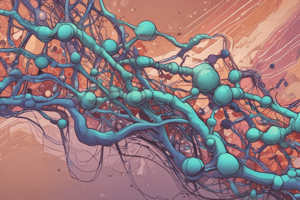Podcast
Questions and Answers
What are the two ways in which prokaryotes terminate transcription?
What are the two ways in which prokaryotes terminate transcription?
- Rho Dependent (correct)
- Rho Efficient
- Rho Independent (correct)
- Rho Recessive
What is Rho Independent transcription termination?
What is Rho Independent transcription termination?
It occurs when an RNA polymerase transcribes a series of Gs and Cs followed by U, causing the polymerase to fall off due to the formation of a stem/loop.
What is Rho Dependent transcription termination?
What is Rho Dependent transcription termination?
It involves a protein hexamer called Rho that follows RNA polymerase, catches up to it, and knocks it off while unwinding the DNA/RNA hybrid.
Rho dependent termination is an imprecise, messy mechanism.
Rho dependent termination is an imprecise, messy mechanism.
What effect does Rho protein have on the DNA/RNA hybrid?
What effect does Rho protein have on the DNA/RNA hybrid?
Rho dependent termination does not require ATP; however, Rho independent termination does.
Rho dependent termination does not require ATP; however, Rho independent termination does.
In eukaryotic transcription, how does RNA polymerase 1 transcription termination occur?
In eukaryotic transcription, how does RNA polymerase 1 transcription termination occur?
In eukaryotic transcription, how does RNA polymerase 2 transcription termination occur?
In eukaryotic transcription, how does RNA polymerase 2 transcription termination occur?
In eukaryotic transcription, how does RNA polymerase 3 transcription termination occur?
In eukaryotic transcription, how does RNA polymerase 3 transcription termination occur?
How does HIV trick the cell into transcribing its RNA?
How does HIV trick the cell into transcribing its RNA?
What is the function of Tat in HIV RNA transcription?
What is the function of Tat in HIV RNA transcription?
Flashcards
Rho Dependent Termination
Rho Dependent Termination
This method involves a protein called Rho that binds to the mRNA strand and follows RNA polymerase. When it catches up, it knocks RNA polymerase off the DNA, causing transcription termination. This process requires ATP.
Rho Independent Termination
Rho Independent Termination
This method relies on a specific RNA sequence featuring a series of G and C nucleotides followed by U's. The GC sequence forms a hairpin loop structure, which causes RNA polymerase to detach from the DNA.
Rho Protein
Rho Protein
This protein is a hexamer that plays a crucial role in Rho Dependent Termination. It binds to the mRNA strand and tracks RNA polymerase, eventually causing it to detach.
Precision of Rho Dependent Termination
Precision of Rho Dependent Termination
Signup and view all the flashcards
Role of Rho Protein in Unwinding
Role of Rho Protein in Unwinding
Signup and view all the flashcards
Rho Dependent Termination: ATP Requirement
Rho Dependent Termination: ATP Requirement
Signup and view all the flashcards
RNA Polymerase 1 Termination
RNA Polymerase 1 Termination
Signup and view all the flashcards
RNA Polymerase 2 Termination
RNA Polymerase 2 Termination
Signup and view all the flashcards
RNA Polymerase 3 Termination
RNA Polymerase 3 Termination
Signup and view all the flashcards
Tat Protein in HIV Transcription
Tat Protein in HIV Transcription
Signup and view all the flashcards
HIV Transcription Mechanism: Circumventing Termination
HIV Transcription Mechanism: Circumventing Termination
Signup and view all the flashcards
Study Notes
Transcription Termination in Prokaryotes
- Prokaryotes terminate transcription primarily through two mechanisms: Rho Independent and Rho Dependent.
Rho Independent Termination
- Occurs when RNA polymerase transcribes consecutive G and C nucleotides, followed by a series of U's.
- The preceding G and C sequences form a stem/loop structure, forcing RNA polymerase off the DNA strand.
Rho Dependent Termination
- Involves a protein hexamer called Rho that follows RNA polymerase along the mRNA strand.
- Rho catches up to RNA polymerase, knocks it off the DNA, and unwinds the DNA/RNA hybrid.
- ATP is required for this process, making it energy-dependent.
Precision of Rho Dependent Termination
- Contrary to some beliefs, Rho dependent termination is extremely precise, occurring predictably at specific locations and times.
Role of Rho Protein
- Rho protein unwinds the DNA/RNA hybrid, allowing the DNA to revert to its double-stranded form and enabling the transcription bubble to close.
ATP Requirement
- Rho dependent termination necessitates ATP, while Rho independent termination operates without it.
Eukaryotic Transcription Termination
- RNA Polymerase 1: Terminates transcription when a termination factor binds to the end of the rRNA gene, prompting RNA polymerase 1 to detach.
- RNA Polymerase 2: Mechanism remains largely unknown; transcription appears to continue past the mRNA end before halting.
- RNA Polymerase 3: Stops transcription after encountering a series of U's; similar to Rho Independent termination in prokaryotes but lacks the GCGCG stem/loop structure.
HIV Transcription Mechanism
- HIV's RNA contains a sequence that forms a stem loop, typically causing transcription termination.
- To circumvent this, HIV utilizes a protein called Tat that binds to the stem loop, recruits cellular factors, and stabilizes RNA polymerase, allowing continued transcription.
- Tat functions as the first protein from the HIV genome, significantly increasing HIV DNA transcription levels.
Studying That Suits You
Use AI to generate personalized quizzes and flashcards to suit your learning preferences.




